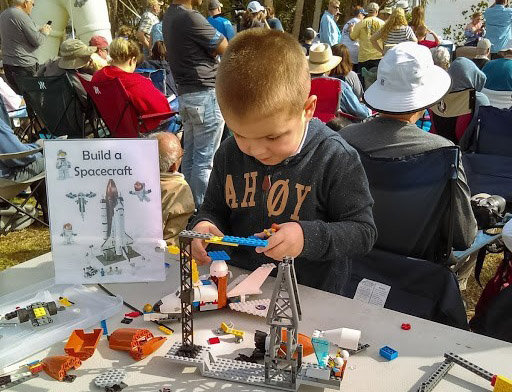The design and construction of the new Astronaut Training Experience at Kennedy Space Center Visitor Complex is almost complete! Opening Fall 2017, ATX will tell the NASA story while promoting STEM learning through activities in this new location. Three design principles were used to guide the creation of the new ATX to host new educational programs that focus on NASA's plans for deep space exploration and the journey to Mars.
Design Principle #1: Our Activities Will Be Authentic STEM
There is no lack for science-related topics in popular media. We can all name movies that have to do with science and particularly with space. The problem is that the line between science and fantasy is so easily crossed. Our commitment as we design the new Astronaut Training Experience is that we will commit to real science and authentic STEM. We are making scientific accuracy a high priority. Visitor complex education crewmembers recently staffed a booth where we guided children and their parents in exploring activities related to surface tension of water, laws of motion, sunspots, and Bernoulli’s Principle. People were fascinated. Not only were they learning real science, but everyone seemed to have fun doing it. Messing around with scientific principles can be incredibly fun!
Design Principle #2: Our Activities Will Be Fun
As we are working on the plans for the new Astronaut Training Experience, the second principle we are considering is that what we will be doing in the center will be designed to be fun. We believe fun is an essential element in attracting people to the study of STEM topics. We expect this fun to manifest itself in multiple ways. First, we are designing such that people will work together in teams. We are creating situations where social interactions will occur. We are being very intentional in assigning tasks such that while every contribution is important, a supporting structure will protect each participant so that everyone will be successful. Second, we are developing some pretty amazing physical experiences. You can expect to launch from Earth, land on Mars, drive on Mars, walk on Mars, and conduct a spacewalk. As we describe the technology that is in development the universal response is, “When can I come in and test it?” As the opening comes closer we will share more information about these experiences. Third, we believe that it is fun to do things that are real. We are connecting the activities as closely as possible to real NASA missions and real scientific research. Fourth, we know that it is fun to be around people who are excited about what they do and want to share the experiences. The education staff has been closely involved with real NASA plant growth experiments in preparation for new activities. It is not an understatement to say that the staff is having a great time. We believe these four factors all contribute to our standard of fun and will contribute to interest by our participants in the study of STEM.
Design Principle #3: Our Activities Will Emphasize Communication and Collaboration Skills (Teamwork)
It has been our observation that many students who have interest in STEM topics can gain from the opportunity to refine their skills in communication and collaboration. It is probably safe to say that this is valuable for everyone. As a result, as we are designing the specifics of the activities we plan in ways to make communications among participants essential to the success of the activity. One of the ways we are doing this is through the use of what we call Training Control Centers (TCC). The Training Control Center is a set of stations where participants serve as a type of “mission control”. The TCC participant is in contact with the simulation participant, can see what that person is seeing, but also has information to pass along the simulation participant to help them accomplish their task. At the end of the simulation the two people trade places and conduct a second, similar simulation. Each person essentially gets the chance to do the simulation twice from different vantage points. We believe that the experience of helping to lead another person through an activity helps a person to understand the task more fully.





